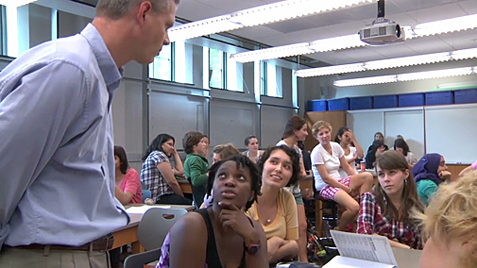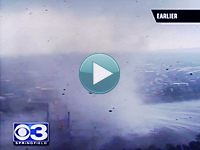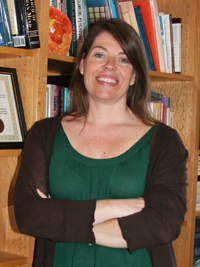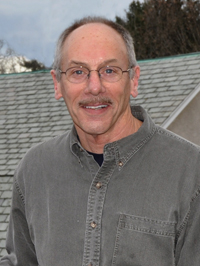

Professor of Engineering Glenn Ellis used knowledge-building practices when he taught Engineering Mechanics in fall 2011. For the 44 students enrolled in the class, this meant not only going beyond solving idealized textbook problems of engineering mechanics but also changing how they learned.
/ Published February 7, 2012
Most people associate an undergraduate education with scholarly lectures, class discussions, reviews and tests. Not so anymore, at least not at Smith College.
Some Smith professors are rewriting the old syllabi and trying a new approach to teaching in their classrooms—an innovation that places a priority on the skills necessary for careers and life in the 21st century, emphasizes higher-level thinking and values the processes of innovation, collaboration and creativity.


A devastating tornado struck Springfield, Massachusetts in June 2011 and affected an estimated 40 percent of the population. A class of Smith engineering students used this extreme of nature as a springboard for their study of engineering mechanics.
It’s called knowledge building—a system of pedagogy developed some 20 years ago by renowned educators Marlene Scardamaila and Carl Bereiter. Knowledge building, say Smith advocates, will better prepare students for the collaborative work environments of the emerging new cultural era widely known as the Knowledge Age.
And now instead of putting the primary focus on lectures, some professors expect their students to work together in groups, discussing what they are learning, asking questions, and developing a productive conversation driven by inquiry, self-reflection and puzzling-out problems together.
“Transformative” is how Professor of Psychology Patricia DiBartolo describes knowledge building after introducing its practices into her teaching some 18 months ago.
DiBartolo used to struggle with the perception that her students were too busy figuring out what the professor wants rather than really listening to and learning the larger concepts of the subject matter. She saw that students did not easily transfer their knowledge across the semester and worried about what they were taking with them beyond the limits of her course.
However, after taking a seminar in knowledge building offered through Smith’s Sherrerd Center for Teaching and Learning, she completely revised how she taught Psychology 192, an introductory course in research methods. She has since co-authored a soon-to-be published scholarly paper, with Professor Al Rudnitsky, about the experience, titled “What Happens When a College Instructor Meets the Learning Sciences.”

Patricia DiBartolo
This new way of thinking and doing in the classroom replaces the traditional teacher-centered learning environment with an idea-centered one in which students take greater responsibility for their own learning, DiBartolo says. As a result, she sees a higher quality of thinking among her students when compared with that of students in the previous classes she taught using traditional teaching approaches.
“The classroom environment is really rich now,” she says. “My students are very engaged. They get a lot further in their understanding of the material than most of my previous students had when I taught them more traditionally. Their discourse is very impressive.
“It changed the frame of reference for my students from asking me ‘what do you want and I’ll give it to you?’ to ‘what is going to help me to really learn this stuff?’ They came to realize that if they collaborate and share their learning with classmates, they can produce better thinking.”
Professor Al Rudnitsky in Smith’s education and child study department has focused his recent research interests on how teachers create learning communities, the role of discourse in deep learning and knowledge-building pedagogy in higher education.
Most of the work using knowledge-building practices, in which students learn to work and solve problems collaboratively, has been happening in classrooms at the K–12 level, he notes. “Typically it is difficult to experiment with new pedagogical approaches in higher education.” Until now.
“What helps make inroads with knowledge building and pedagogical change in higher
education is that it strengthens critical thinking and writing capacities, and casts students
as knowledge creators — something which faculty can readily relate to and appreciate.

Al Rudnitsky
“The current national conversation on higher education pedagogy—including the theoretical concepts of the teaching and learning process known as the ‘learning sciences’— emphasizes deep learning and idea-centered student engagement with big questions, with inquiry, as well as collaboration to effectively solve problems and advance knowledge,” Rudnitsky says.
In December, Smith was awarded a $153,000 grant for a key initiative, “Knowledge Building: A Transformative Approach to Undergraduate Education.” The grant was received from the Davis Educational Foundation, established by Stanton and Elisabeth Davis after his retirement as chairman of Shaw’s Supermarkets, Inc. The award will support more faculty-led development seminars through the college’s Sherrerd Center.
“Good teaching is about creating good learning environments,” says Kevin Shea, the center’s director and associate professor of chemistry. And one of the core goals of the Sherrerd Center is to provide opportunities for “faculty to learn from one another by sharing innovative teaching practices and strategies for improving student learning.”
The Sherrerd Center has been offering seminars and workshops on knowledge building for three years. “Currently all of the faculty who are experimenting with knowledge building have come through the Sherrerd seminars,” says Rudnitsky, who is also a member of the Sherrerd Center advisory board.
Smith is one of the first institutions of its kind to apply knowledge building to the liberal arts, establishing it as a leader in teaching and learning pedagogy, he says.
Consider, for instance, EGR 270 Engineering Mechanics, offered each fall. In it, students are introduced to fundamental theoretical principals and analysis of the mechanics of continuous media, including solids and fluids.
This fall, for the first time, Professor of Engineering Glenn Ellis used knowledge-building practices when he taught the course.
For the 44 students enrolled in EGR 270 this meant not only going beyond solving idealized textbook problems of engineering mechanics but also, according to Ellis’ syllabus, changing “how you learn in our engineering courses.”
The semester began with a walking tour through the storm-ravaged East Forest Park neighborhood of Springfield, Massachusetts, where an EF-3 tornado, with speeds of up to 160 miles per hour, touched down three months earlier. The twister had sheared off the tops of roofs and trees, snapped power lines, sent bricks and other materials airborne and destroyed homes and businesses along its 6.2-mile path through the city. According to news accounts, the tornado affected an estimated 40 percent of the city’s population.
“To do knowledge building requires emotional engagement,” says Ellis. “And you cannot visit these neighborhoods without being emotionally engaged.”
“We were learning in a completely different way now,” says Wiame El Bouhali ’14 of Sale, Morocco, of her experience in Ellis’ class. “Instead of only sitting and listening to the professor lecture to us, we were actually going out and collecting our own information and coming up with new ideas and solving problems for ourselves.”
After touring the neighborhood to get a sense of the magnitude of destruction from the tornado, Ellis asked the students to process the information they had gathered and formulate questions about what they observed. In answering and improving these questions, students created new ideas and designs while tackling such issues as failure modes, building codes, the ethics of safety, and the social aspects of how human beings interact with their own environment and community.
As Ellis sees it this is all preparing for the real world. Indeed, to succeed and adapt to a changing world after their formal education is complete, students will need to be able to be creative thinkers and innovative doers. Likewise, knowledge-building skills better prepare students for the job market as well, he says.
According to the National Science Board, companies will no longer be looking simply for analytic skills when interviewing prospective engineers for jobs. “They will be looking for passion, adaptability and eagerness to learn,” says Ellis, who joins DiBartolo this March in presenting a workshop, “Designing Learning Environments that Prepare Students for Success in the Knowledge Age” at the American Association of Colleges and Universities conference.
Of potential engineering employers, Ellis tells his students, “They will want you to be an innovator who can collaborate effectively in interdisciplinary and multicultural environments. They will want excellent communicators and leaders. It is well documented that traditional approaches to engineering education need to drastically change to prepare you for this new age.”
Whether they are teaching an engineering or education course, advocates say that when they work the idea-centered knowledge-building practices into the curriculum, the quality of thinking gets deeper and the ability to work more creatively expands. Many students agree.
As Emily Morris ’13 of Wyndmoor, Pennsylvania, puts it, “When you do knowledge building, you are engaging in critical thinking right from the start. It’s not just the best piece that gets saved for the end of the semester.”
Reflecting on the fall semester in engineering mechanics, Ellis says. “This was about a community of learners who were working toward developing their own new ideas. It wasn’t about pleasing me. It was about asking questions and then working together to explore and improve their ideas. The research says you can’t feed students knowledge.”















